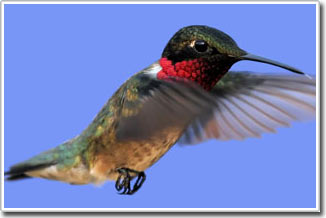Study bird brain to solve questions about speaking ability
Although they belong to many different families in the genealogy of birds, vocal learning birds use similar brain structures to store their voices. Neurobiologists at Duke University Medical Center have found an answer to this confusing similarity.
Of the three groups of birds that are capable of vocalization - singing birds, parrots and hummingbirds - the brain structure for singing and learning to sing lies in the area of motion control. The team also found that the motion control region is responsible for many functional similarities to the brain region for singing. This means that the way to learn pronunciation evolved from how to manipulate motor muscles.
The author of the study, Dr. Erich Jarvis, a professor of neurobiology, hypothesizes that these ancient ways, controlling limb movement and body, contained both position and vascular system. of structures for learning and imitating sound. These findings help solve the riddle of why people can talk to both voice and hand but chimpanzees can only speak by hand.
Jarvis said: 'In the most specialized way, speech is the ability to control the learned movements of the larynx. Perhaps human language learning has evolved similarly to those of these birds. It is also possible that the evolution of brain regions for learning in birds and humans uses the common motor system, the likelihood that has occurred before both birds and humans separate ancestors. '
 According to the Director of the National Institute of Health Research (NIH) Elias A. Zerhouni, 'this innovative study illustrates the deep and innovative thinking methods recommended by the NIH Pioneer Award. Discovering the brain region of speech that lies in the part of the brain that controls body movement has brought unexpected insights into the origin of spoken language and opened new research methods for speech disorders in humans. '
According to the Director of the National Institute of Health Research (NIH) Elias A. Zerhouni, 'this innovative study illustrates the deep and innovative thinking methods recommended by the NIH Pioneer Award. Discovering the brain region of speech that lies in the part of the brain that controls body movement has brought unexpected insights into the origin of spoken language and opened new research methods for speech disorders in humans. '
Jarvis and his colleagues examined different, non-verbal and non-learning birds: garden warblers, zebra finches, budgerigars, Anna hummingbirds and doves. Their method involves observing and recording bird behavioral signals, then learning which genes are active in the bird's brain when the birds move and sing in certain ways.
Jarvis said: 'When we used behavioral molecular mapping, we obtained gene patterns in the brain that are as bright as magnetic resonance images. This is the first work to map the part of the frontal brain that controls bird movement. The front brain is the largest part of the brain and consists of many parts responsible for thinking, learning and awareness. '
When all birds speak, their sounds are often caused by genetic programming. Only singing birds, parrots and hummingbirds are capable of learning to sing. This type of language learning is similar to the way people learn to speak.'Based on that data, we think there is a kind of substrate that existed before, called the way the brain moves first, leading to the evolution of similar learning styles in three different families. '
The relationship between movement and language learning extends to people. The human brain structure for speech is also ahead, even inside, motion control areas.'We can reliably argue that people in speaking regions also evolved from available motor muscles. These capabilities date back to the common ancestors of reptiles, birds and mammals, a creature called stem amniotes who lived 300 million years ago. '
Research results from birds are consistent with the hypothesis that the language is preceded by body language, or communication based on movement (one of the explanations for the origin of spoken language). Both humans and chimpanzees use their hands when communicating, and children make signs before they start talking.' Signing is one of the things that comes with completely natural speech. Areas of the brain for gestures can be modified and used for speech. '
- The bird speaks Japanese like a human
- Shocking findings about human readability
- Questions about recruiting Google 's brain damage
- The 17 most brainwarming questions of technology corporations
- 'Brain twist' with easy questions but 99% of people give up
- 2 childish puzzles take 10 minutes, adults need an hour to answer
- Detects two hemispheres that work independently
- Answer these 3 questions correctly, you will be genius or schizophrenic
- This is a bird known as the 'female canopy' of the animal world
- Shocking discovery about the left brain and right brain
- 5 super-difficult IQ test questions of the FBI, tall 6-pack without intelligence, also carried the suitcase
- The bigger, the more likely the
 Animal 'suffering' after hibernation
Animal 'suffering' after hibernation Why do goats climb well?
Why do goats climb well? Scientists were surprised to see chimpanzees eating turtles
Scientists were surprised to see chimpanzees eating turtles Giant catfish died deadly due to drought in Thailand
Giant catfish died deadly due to drought in Thailand